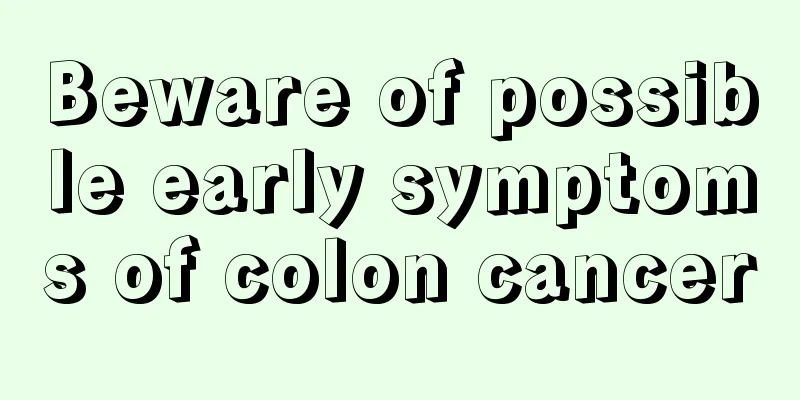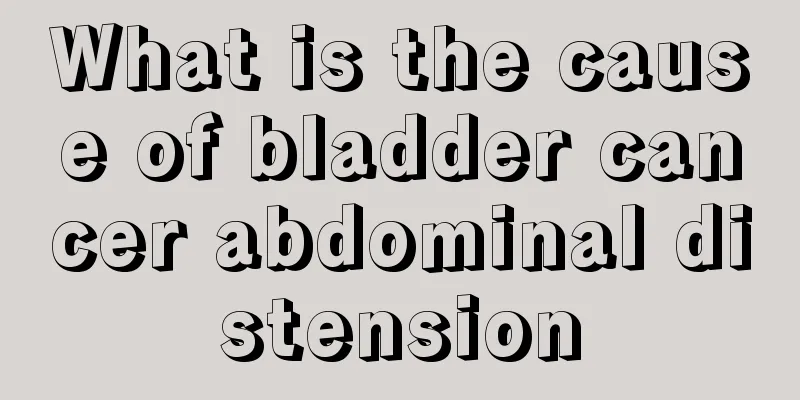Beware of possible early symptoms of colon cancer

|
Colon cancer refers to malignant lesions of the colon mucosal epithelium caused by multiple carcinogenic factors such as environmental or genetic factors. The incidence rate is highest in the 40 to 60 age group. There are approximately 8 million new cases worldwide each year, accounting for 10% to 15% of all malignant tumors. Colon cancer has an insidious onset, often without obvious clinical manifestations in the early stages, and develops slowly. By the time obvious symptoms appear, it is usually in the middle or late stages. Its mortality rate ranks third among malignant tumors in my country, second only to lung cancer and liver cancer. Therefore, sufficient attention should be paid to some early clinical manifestations that may be colon cancer, so as not to miss the precious opportunity for treatment. Positive fecal occult blood Occult blood in routine stool examination is often the earliest symptom of colon cancer. At this time, the stool is no different from normal stool when observed with the naked eye, and it cannot be confirmed under the microscope in laboratory examination. At this time, gastrointestinal bleeding can only be detected by chemical methods, and the daily bleeding volume is generally about 5ml. Changes in stool characteristics As colon cancer develops further, blood in the stool can be seen, which is the most prominent early manifestation of colon cancer. In addition, dysentery-like pus and blood in the stool can be seen. When space-occupying lesions appear in the intestine, the stool shape will become thinner. Changes in bowel movement patterns In addition to changes in stool quality, bowel movement patterns can also be affected by cancer. In the case of right-sided colon cancer, the early symptoms are thin stools and increased bowel movement frequency. When the tumor grows and affects the passage of stool, alternating diarrhea and constipation may occur. In contrast, left-sided colon cancer often presents as difficulty in defecation, which worsens as the cancer progresses. stomach ache Abdominal pain is also a common nonspecific symptom in the early stage of this disease, which is more common in the right colon. It is manifested as dull pain in the right abdomen, or referred pain in the right upper and middle upper abdomen. Because the lesion can enhance gastrointestinal reflexes, the abdominal pain worsens after meals. When complicated with intestinal obstruction, it can manifest as worsening pain or paroxysmal colic. |
<<: The relationship between Epstein-Barr virus and the incidence of nasopharyngeal carcinoma
>>: What are the symptoms of colorectal cancer
Recommend
Is frequent heartburn a sign of stomach cancer? These conditions can cause heartburn
Among the common abnormal reactions of the stomac...
Will angina pectoris cause sudden death? Timely treatment is the most important thing
Angina pectoris is most common in men over 40 yea...
What is the relationship between bone age and age?
In order to understand the bone condition of thei...
Dietary tips for bone cancer that require special attention
After suffering from bone cancer, the patient'...
Can I eat Panax notoginseng powder if I have a bad stomach?
Many people will wonder whether they can eat Pana...
What should I do if I have obsessive-compulsive disorder?
Caring for hygiene is a very good habit for peopl...
What eye drops to use for itchy and painful eyes
For many people, itchy eyes are always the cause ...
How to take better care of liver cancer? 4 good ways to actively prevent liver cancer
Liver cancer is also one of the more common cance...
What to do if your child can’t calm down while studying
If a child cannot concentrate on studying, parent...
How to remove stains from kitchen quartz countertops
The sanitation in the kitchen will directly affec...
How to remove scale from electric water heater
We use electric water heaters at home almost ever...
Can eating small meals frequently help you develop a lean body?
Nowadays, many people do not control themselves i...
How much does biological therapy cost to treat brain cancer
Brain tumor is a common disease. There are many b...
Where do shark fins come from?
Shark fin is a relatively precious thing. Eating ...
Is it necessary to prevent colon cancer after cholecystectomy?
The main function of the gallbladder is to store ...









